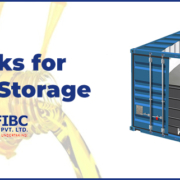How Can You Reduce Your Carbon Footprint With Flexitanks?
The rising temperature throughout the globe in recent years saw catastrophic change in global climate. It reflects on continuous increase in global warming along with depletion of fresh drinking water in locations along rising of hard water level in other locations. This has become of the major cause of concern for humans and organizations throughout the world. To control this rise in temperature drastic measures has been taken to create business process in an environmentally manner, which can contribute to control global warming and eventually protect the environment. If your business wishes to contribute to such a noble cause, switch to Flexitank for your storage and transportation of product, this will allow you directly or indirectly contribute to controlling of global warming.
Let’s take a stroll down the production and quality lane of Flexitanks to see how it helps reduce carbon footprint throughout the globe.
Understanding what is Carbon Footprint
A carbon footprint is the measure of ozone depleting substances—principally carbon dioxide—delivered into the air by a specific human action. A carbon footprint can be a wide measured or be applied to the activities of an individual, a family, an occasion, an organization, or even a whole country. It is generally estimated as loads of CO2 transmitted each year, a number that can be supplemented by loads of CO2-equivalent gases, including methane, nitrous oxide, and other greenhouse gases.
How Carbon Footprint is calculated?
Calculating a carbon footprint, takes a ton of components into consideration. For instance, energy used during production of an object or component. Material used to create the energy, material used to create the object and its chemical structure and how it reacts to environmental exposure. All chemical tangible that produces greenhouse gases directly highlights the amount of carbon footprint created by an organization.
Why Flexitanks Are a Sustainable Choice?
Flexitanks are the latest iteration in the development of bulk liquid storage containers for non-hazardous liquids. A Flexitank is a mass fluid storage compartment whose walls comprise of different layers of polyethylene. The internal walls are made of adaptable polyethylene while the external walls are made of a more grounded joined material called polypropylene. Since the mass of a Flexitank is flexible, it makes sense that it requires an outside design to help it when it has been topped off with a fluid. By utilizing previously existing standard steel containers, Flexitanks are giving a more secure, better, and more savvy option in contrast to modified delivery big haulers for mass fluid transportation.
How Flexitanks help reduce Carbon Footprint
There multiple reasons how Flexitanks can contribute to reduction of carbon footprints. Some of the major understandings are highlighted below:
- Flexitank uses progressive fabricating strategies to plan and construct that require less resource to assemble.
- The Flexitank doesn’t utilize bulkheads, which evades metal bars, wood boundaries, and different adornments needed to fortify shipping containers. This likewise diminishes the measure of waste made from damaged bulkheads.
- Global organizations with ecological targets pick Flexitank since its carbon footprint is more than 40% less compared to its rivals.
- Eliminates conventional longitudinal seams with one piece construction thus reducing energy requirement during production
- Flexitanks are made using ethylene polymers to ensure supreme safety, strength and durability hence are reusable bring down the requirement on multi-load production
- Flexitanks Offers high stretch and energy absorption capacity
- Flexitanks Provides internal hygiene of highest order hence bringing down a reaction within the tank for liquids which can release greenhouse gases
The evidence clearly showcase how opting to use Flexitank can help your business to contribute for such a noble cause, of bringing down carbon footprint and preventing in release of large volume of greenhouse gases, allowing you directly or indirectly contribute to controlling of global warming.
Why Choose Fluid Flexitanks for Flexitanks?
Fluid Flexitanks manufactures’ premium quality Flexitanks that is ideally suited for storing and transportation of liquid and other items. The Flexitanks are manufactured by adhering to all the set standards that are developed by the government to bring down greenhouse gases production and decrease carbon footprint of the organization, so that none of the users get even a single chance to complain about our products. With several years of experience and expertise, Fluid Flexitanks is one of the industry leaders in manufacturing Flexitanks that can help you boost your business not only through advantages of using Flexitanks, but also through indirect contribution to environment by helping bringing down carbon footprint.










